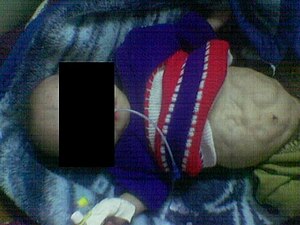Prune belly syndrome
| Prune belly syndrome | |
|---|---|
 |
|
| Prune belly syndrome in an Egyptian child with Down syndrome. | |
| Classification and external resources | |
| Specialty | medical genetics |
| ICD-10 | Q79.4 |
| ICD-9-CM | 756.71 |
| OMIM | 100100 |
| DiseasesDB | 31089 |
| MedlinePlus | 001269 |
| eMedicine | med/3055 radio/575 |
| MeSH | D011535 |
Prune belly syndrome, also referred to as abdominal muscle deficiency syndrome, congenital absence of the abdominal muscles, Eagle-Barrett syndrome,Obrinsky syndrome,Fröhlich syndrome, or, rarely, triad syndrome, is a rare, genetic birth defect affecting about 1 in 40,000 births. About 97% of those affected are male. Prune belly syndrome is a congenital disorder of the urinary system, characterized by a triad of symptoms. The syndrome is named for the mass of wrinkled skin that is often (but not always) present on the abdomen of those with the disorder.
Prune-belly triad consists of: Cryptorchidism, abdominal wall defects and genitourinary defects:
Other Symptoms include:
Prune belly syndrome can be diagnosed via ultrasound while a child is still in-utero. An abnormally large abdominal cavity resembling that of an obese person is the key indicator, as the abdomen swells with the pressure of accumulated urine.
In young children, frequent urinary tract infections often herald prune belly syndrome, as they are normally uncommon. If a problem is suspected, doctors can perform blood tests to check renal function. Another study that may suggest the syndrome is a voiding cystourethrogram.
PBS is far more common in males. Autosomal recessive inheritance has been suggested in some cases. A homozygous mutation in the muscarinic cholinergic receptor-3 gene (CHRM3) on chromosome 1q43 was reported in one family.
Prune belly syndrome can result in distention and enlargement of internal organs such as the bladder and intestines. Surgery is often required but will not return the organs to a normal size. Bladder reductions have shown that the bladder will again stretch to its previous size due to lack of muscle. Complications may also arise from enlarged/malformed kidneys, which may result in renal failure and the child's going on dialysis or requiring a kidney transplant. With proper treatment, however, a longer, healthier life is possible.
The type of treatment, like that of most disorders, depends on the severity of the symptoms. One option is to perform a vesicostomy, which allows the bladder to drain through a small hole in the abdomen, thus helping to prevent urinary tract infections. Similarly, consistent self catheterization, often several times per day, can be an effective approach to preventing infections. A more drastic procedure is a surgical "remodeling" of the abdominal wall and urinary tract. Boys often need to undergo an orchiopexy, to move the testes to their proper place in the scrotum.
...
Wikipedia
